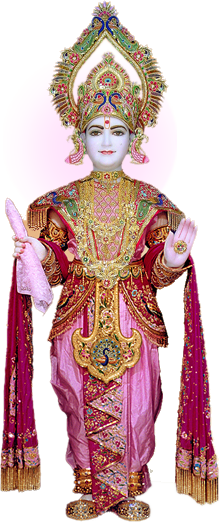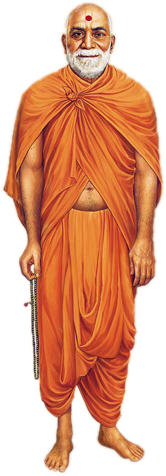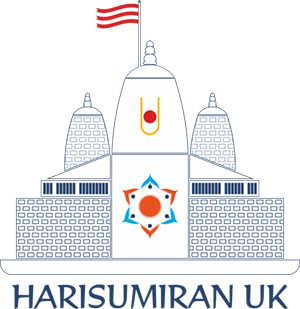
Lord Swaminarayan

Prabodhjivan Swamiji

Hariprasad Swamiji

Yogiji Maharaj

Shastriji Maharaj

Gunatitanand Swami
Appearance: 1781 A.D
Name: Ghanshyam Maharaj. (Known as Nilkanth Varni in Van-Vicharan)
Name After Initiation: Swami Sahajanand
Place of Birth: Chhappaiya (Dist. Ayodhya, Uttar Pradesh, India)
Life Work:
- Initiated Swaminarayan Sect
- Propagated Vishishtadwaita (Dualism) at the age of seven
- Initiated 500 Paramhansas at the age of 21
- Put an end to violent oblation, traditions of sati (to sit on the pyre of the dead husband and burn oneself), child marriage, infanticide
- Gave first prose in binded form in Gujarati language
- Special worshipping areas for women
- Promulgation of Nishkaam Dharma and Nirman Dharma
- Absolute and total celibacy for saints after initiation
End: 1830 A.D.
Lord Swaminarayan manifested Himself in the year 1781 A.D. 224 years ago in the small hamlet of Chhapaiya near Ayodhya in Northern India. As the proverb goes, ‘The qualities of son are known from his birth.’ Similarly, Ghanshyam showed a lot of dexterity in deeds and divinity in action during His tender age. As Bhagavatacharya Sri Markendey prophesied, ‘this kid is the manifestation of God. He shall bring absolute happiness and prosperity to one and all whoever will come into His divine contact.’ True to the words, He won the scriptural debate among the pandits of India in Kashi at the age of seven years.
He renounced the worldly life at the age of eleven and was known as Nilkanth Varni. During His seven and half years of sojourn in the jungle, He walked the whole span of greater India from greater Himalayas to the end of land, Kanyakumari in South and Assam in East and Gujarat in west. At the end of His entire journey which set the path for the benefit for all and triumph over all evil, He settled in the village of Loj in Saurashtra.
He accepted Ramanand Swami as a Guru for all humanity:
- Let me suffer million times but do not let my devotee suffer one bit.
- My devotee shall never go hungry even if he is the victim of seven famines.
- I shall take my devotee to the abode of God – Akshardham at the end of his mortal life.
- I shall be present on this Earth eternally through the God-Ordained Saint who has renounced women, wealth and fame.
He initiated 500 Paramhansas (saints) in one night at the age of 21. He was the mentor of millions of persons who had never visualized the happiness that was to be their domain. Most of them were uneducated warriors and farmers. He conquered sword wielding warriors not by wielding sword but immersing them in His divine love.
He resurrected them from the brink of barbarism and elevated them to the level of God fearing devotees. He was probably the most advanced reformer who worked at the lowest strata of the society enriching them to be the part of the happy, serene and truthful society. He put an end to practice of Sati, infanticide and many other vices that plagued the society of yore. Joban Pagi, Bhaguji, Alaiya Khachar etc. are the examples of His unflinching effort to revive humanity to it’s’ best. He wrote ‘Shikshapatri’, 212 verses of perennial importance that if followed, would bring ethereal peace and prosperity; in the material world and metaphysical world. He also dictated discourses known as ‘Vachanamritam’, the first compiled prose in the history of Gujarati Language.
He left his mortal body at the age of 49 yrs., living an indelible impression on the future. Millions of lives were transformed from human to superlative being through His divine contact.
He always said, ‘The objective of My manifestation in this world is to cultivate Service and Devotion.’ Service unto Humanity and Devotion unto God are the two goals which every follower of Lord Swaminarayan followed. In a nutshell, He was the propagator of Nishkam-Dharma, the spirituality of desirelessness.
Appearance: 1953
Name: Narottam Bhai
Name After Initiation: Sadhu Prabodhjivandas
Place of Birth: Vanthli (Village near Junagadh)
His Divine Holiness & Pragat Guruhari Param Pujya Prabodhjivan Swamiji Maharaj is the spiritual heir to His Divine Holiness Hariprasad Swamiji Maharaj, and the 6th successor of Bhagwaan Shree Swaminarayan. He is the head of what is affectionately called the “Hariprabodham Parivar”.
His mission is to empower youths to live a spiritually balanced life that encourages them to be good citizens to the broader community. His inspiration, guidance and love help youth live a positive, addiction free, and focused life.
Born on August 17th, 1953 at 9:00 pm in Vanthali, Gujarat as Narotambhai Patel, His Divine Holiness Prabodhjivan Swamiji Maharaj has lived a positive life filled with spirituality since birth. On June 1st, 1972 at the age of 18 Narotambhai received His “Parshadi Diksha”, which was followed by His “Bhagvadi Diksha” on June 8th, 1972. He is initiated as a Sadhu by His Guru His Divine Holiness Hariprasad Swamiji Maharaj and given the name “Sadhu Prabodhjivan Swamiji Maharaj”.
His Divine Holiness Prabodhjivan Swamiji Maharaj spent the next 49 years engrossed in the service of His Divine Holiness Hariprasad Swamiji Maharaj. Over this time He inspired hundreds of thousands of devotees around the world through His sincerity, dasatva, devotion and dedication onto His Divine Holiness Hariprasad Swamiji Maharaj as the ideal devotee.
Over the course of these 51 years, His Divine Holiness Prabodhjivan Swamiji Maharaj showed glimpses of His divinity to countless devotees.
Appearance: 1934
Name: Prabhudas Bhai
Name After Initiation: Sadhu Hariprasaddas
Place of Birth: Aasoj (Village near Baroda)
Prabhudasbhai (Swamiji’s name before sainthood) was born in Asoj, a small village near Baroda in Gujarat on May 23th 1934. He was brilliant in His studies and modest in acclaiming His achievement since His childhood. Prabhudasbhai was initiated as Sadhu by Guruhari Yogiji Maharaj on Sharadpoornima, 10th October 1965. While proffering diksha on His chosen devotee, Guruhari Yogiji Maharaj proclaimed, ‘This diksha is like the diksha proffered upon M.A.M. Gunatitanand Swami by Lord Swaminarayan in Dabhan (the place where M.A.M. Gunatitanand Swami was initiated into sainthood).’ These words, coming out of Yogiji’s divine mouth, were not mere eulogy. These words were futuristic and were spoken by a visionary. It showed the path which the prospect had to take in the future. True to this prophecy, Swamiji became the fifth spiritual successor of the legacy of Lord Swaminarayan. He resolutely followed the regimen of Guruhari Yogiji Maharaj’s volition. To streamline the resolution, He founded Yogi Divine Society.
He toiled day and night to foster the principle of Atmiyata (Spiritual Affinity with one and all) which is just the other way to foster the principle of samp, suhradbhav and ekta. Swamiji has loved all. He is known as the most secular saint in the contemporary world. Swamiji identifies all with Yogiji Maharaj and that is the reason he is acclaimed as a universal saint who strives to cultivate humanity, devotion and harmony in an individual, in the society, in the nation and in the world. His dictum is, ‘O Lord! Whether the other person becomes Atmiya (spiritually harmonious) or not, please make me Atmiya, (spiritually harmonious)!’ meaning, a devotee irrespective of the surroundings, circumstances, nature, temperament has to be harmonious and devoted to His Lord and the spiritual master. Today, because of His divine prowess and sublime selfless love, there are thousands of youths whose lives are the model of true piety, devoid of vices.
His magnanimity has led the communion to live the life in accordance to the set principles of Lord Swaminarayan and the saints without artificial persuasion.
His life and work could be more justified when we navigate through the activities inspired by Him, carried out under the auspices of Yogi Divine Society.
Appearance: 1892 A.D.
Name: Jinabhai
Name After Initiation: Sadhu Gnanjivandas
Place of Birth: Dhari (Dist. Amreli, Saurashtra, India)
Life Work:
- Nurtured service and devotion (Nishkam Dharma and Nirman Dharma)
- Initiated 51 educated youths as sadhus
- Propagated Swaminarayan Sect outside India
End: 1971 A.D.
Guruhari Yogiji Maharaj was born in Dhari in Saurastra. His name was Jinabhai and true to His name, He remained Jino (a little one) throughout His mortal life. He was the forth successor of the divine legacy of Lord Swaminarayan.
At the very small age, when a child is not even aware of any rationalism, He used to serve the local temple in Dhari waking up at 4.00 AM in the morning. He started performing the temple routine at the age of seven. He would bathe the idols of Lord, apply sandalwood paste and perform Aarti like an experienced pujari. His devotion and servitude was not only exemplary, it was supremely saintly. He was the byword of sevakbhav (the model disciple of His spiritual master) and true unreserved compassion.
He was initiated as sadhu and named Sadhu Gnanjivandas. He was the ultimate model of devotion and humility. Inspite being the head of the Akshar mandir, Gondal; He was found in Kitchen in the wee hours of morning, noon or night. Tolerance was the synonym and devotion was intrinsic. For Sadhu Gnanjivandasji, servitude was not the quality to be acquired but the manifestation. Insults were His eulogy and treated one as the offering from the Lord.
Guruhari Shashtriji Maharaj, defining His unison with Yogiji Maharaj, often exclaimed, “Huun te Jogi Ane Jogi te Hun.” (I am Yogi and Yogi is Me) He populated the idea of ‘Samp, Suhradbhav and Ekta’ – the practical ideology of unity and universal brotherhood.
He was an ever-smiling personality, the true replica of a mother without the malice of the substance world. He was the one who promulgated and promoted humility as an asset and modesty as virtue, the most important for an aspiring devotee. He was, one person who put the beliefs in devotion and service in the devotee through His idyllic behavior.
Appearance: 1865 A.D
Name: Dungar Bhagat
Name After Initiation: Sadhu Yagnapurushdas
Place of Birth: Mahelav (Dist. Anand, Gujarat, India)
Life Work:
- Propagated dual form of worship – Shri Akshar-Purushottam Yugal Upasana
- Built five pinnacle temples
- Idol installation of Shri Akshar-Purushottam Maharaj in each of the temples
End: 1951 A.D.
He propagated the dual form of worship of Shri Akshar Purushottam, the essence of Swaminarayan sect; the philosophy which had gone unnoticed among the followers ! Akshar Purushottam – dual worship is a faith of devotion to God with His most trusted and preferred devotee, Akshar.
This dual worship helps us to understand the intricacies of spirituality of pleasing Parbrahm with the help of Akshar. A pupil needs teacher to accomplish his academic goals. Similarly, any disciple needs Akshar as his guide to realize his spiritual goal.
Born in Mahelav, a small town in Gujarat, India, His personality was effectual. His prowess was evident from His illustrious childhood. His deeds evidenced the devotion and spirituality that was unseen so far. With his servility, He pleased one and all. Anadi Mahamukta Bhagatji Maharaj was very much pleased with Him. That made Him the recipient of the intrinsic knowledge of Lord Swaminarayan and M.A.M. Gunatitanand Swami. He studied hard to compliment the knowledge He had received from Anadi Mahamukta Bhagatji Maharaj.
He was initiated as a Sadhu and named Yagnapurushdas. His dexterity was second to none in saintliness and learning. He became Shashtri in Sanskrit Scriptures; the degree that earned Him the nickname, Shashtriji Maharaj.
He experienced contemptuous behaviour from the society. Undeterred in His persuasion of establishing the worship of dual nature as propounded by Lord Swaminarayan, He built five temples through which he spread this message of devotion to Shri Akshar Purushottam Maharaj.
These five temples are the pinnacles of accomplishments in the history of Shri Akshar Purushottam worship. At the end of His mortal life, He indicated Guruhari Yogiji Maharaj as His successor, the manifestation of Aksharbrahm.
Appearance: 1785 A.D
Name: Mulji Sharma
Name After Initiation: Sadhu Nirgunanand ; Gunatitand Swami
Place of Birth: Bhadara (Dist. Jamnagar, Gujarat, India)
Life Work:
- Built the temple in Junagadh
- Defined the theory of Sakaar Brahman
- Imbibed the theories of devotion and servitude as preferred by Sahajanand Swami
- Incarnation of Brahm
End: 1867 A.D.
According to Lord Swaminarayan’s boon, “I shall grace this planet perpetually through the God-Ordained Saint who is absolutely pious and has renounced the company of women, wealth and fame”, He blessed us with the legacy of saints who were and are the beacon of true faith and empathy in this fractured world.
The first saint in this legacy of welfare promulgated by Lord Swaminarayan was Anadi Mool Akshar Moorti Shri Gunatitanand Swami. He was the incarnation of Brahm and Lord Swaminarayan was the embodiment of Parbhram. He was the absolute sevak (aide) of the Lord. It was said that He moved when the Lord’s eyes moved. He was the lexicon of Lord’s wish. Physically, He was born in Bhadara, a tiny village on the banks of river Und on the auspicious day of Sharad-Poornima (autumn solstice Full moon) in the year 1785 A.D.
He was initiated as a saint and was named Nirgunanand – the man unbound by the three physical bodies.
He was also named as Gunatitanand Swami – man beyond the boundaries of material world and virtues. Essentially, Nirgunanand and Gunatitanand signify the same meaning. He was the embodiment of service and devotion, the crucial points to gratify Lord Swaminarayan. He was not a mythical figure. He was the model for all the devotees who aspired to be the supreme sevak of the Lord. He strode this Earth propagating the divine message of Lord Swaminarayan. He was the first natural successor of Lord Swaminarayan.
